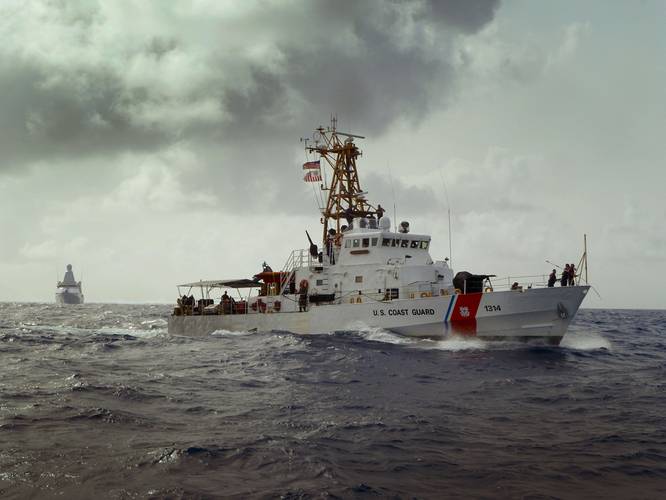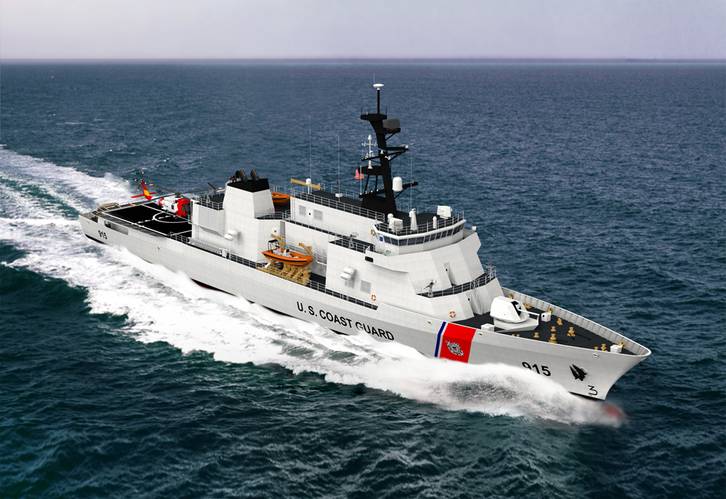USCG: The Fleet Faces Forward
Coast Guard Replacing Aging Ships with 91 New Cutters
The numerous cutters and craft of the U.S. Coast Guard —from the sail training ship Eagle to the large oceangoing patrol ships; from polar icebrakers to small utility boats — form a formidable fleet to meet the many challenging assignments undertaken by the service. In 2014 the Coast Guard continues its recapitalization program with its National Security Cutter (NSC), Fast Response Cutter (FPC) and Offshore Patrol Cutter (OPC).
The service plans to procure 91 cutters (8 NSCs, 25 OPCs and 58 FRCs) to replace are 90 aging cutters and patrol boats. According to a Feb. 14 report by the Congressional Research Service (CRS), “The NSC, OPC, and FRC programs have a combined estimated acquisition cost of about $21.1 billion, and the Coast Guard’s proposed FY2014 budget requested a total of $716 million in acquisition funding for the three programs.”
The new ships will feature more automation and therefore smaller crews.
“Many of these 90 ships are manpower-intensive and increasingly expensive to maintain, and have features that in some cases are not optimal for performing their assigned missions,” the CRS report said.
The USCGC Bertholf class NSC represents the Coast Guard’s largest and most capable general-purpose cutters, costing about $684 million each. It is, in fact, a multi-role combatant. Three are in service and three more are under construction oat Huntington Ingalls in Pascagoula, Miss. A total of eight ships are planned as replacements for the 12 Hamilton-class of 378-foot high endurance cutters.
“In October we christened our fourth National Security Cutter, the Hamilton, which will soon join Bertholf, Waesche and Stratton,” said Commandant of the Coast Guard Adm. Bob Papp aduring his 2014 State of the Coast Guard address on Feb. 27. “We will christen our fifth, the James, this summer. Our sixth, the Munro, is in production. We have contracted for the major propulsion systems and other equipment for number seven, the Kimball. With FY14 spending in place, we now have the construction funding for Kimball and we have received the funding to purchase long lead time materials for our eighth NSC, the Midgett.”
The new 418-ft., 4,434 ton NSCs have smaller crews–around 122 on Bertholf—than the 170 people on the smaller 378s. Bertholf has both diesels and a single gas turbine, which together can achieve speeds above 28 knots, and 24 knots on diesels alone.
Bertholf is the first Coast Guard vessel to carry the newest version of the Close-in Weapon System (CIWS 1B), and the BAE Systems Bofors 57mm gun for use against both air and surface targets
The biggest difference you can’t see is the total ship computing environment, and SCIF (Sensitive Compartmented Information Facility), which provides “information assurance” and permits better command and control and interoperability than any previous cutter.
“They add a level of capability that moves the Coast Guard to even more effective service at greater value for the taxpayer,” said Papp. “And with continued support in FY15, we hope to soon complete one of the most significant acquisition projects our history.”
The U.S. Coast Guard awarded three firm fixed-price contracts on Feb. 11, 2014, for preliminary and contract design (P&CD) for the Offshore Patrol Cutter (OPC) acquisition project. The contracts — worth about $22 million each — were awarded to Bollinger Shipyards Lockport LLC (Lockport, La.), Eastern Shipbuilding Group Inc. (Panama City, Fla.) and General Dynamics, Bath Iron Works (Bath, Maine). From these three preliminary designs a single team will be selected for detailed design, and that team will build the initial ship with an option to build up to ten OPCs. The Coast Guard said it is “using a deliberative, two-phased design-build strategy to acquire the OPC. This approach establishes stable requirements and design early on in the life of the acquisition, which helps mitigate cost and schedule risks.”
The OPCs will be smaller than the NSC, less capable, and presumably less expensive.
The Coast Guard plans to build 25 of them to replace the 14 ships of the 210-foot Reliance-class medium endurance cutters and 13 270-foot “Famous class.” The 1,400 ton 210s entered service 1964 and 1969, while the 1,800-ton 270s are newer, commissioned between 1983 and 1990.
There is also the USCGC Alex Haley (WMEC 39), a converted U.S. Navy ocean going salvage ship. At 283 ft. and 3,400 tons, Alex Haley she is based in Alaska where she conducts fisheries patrols and search as rescue duties, but she is more than 30 years old.
The new OPCs will have greater range and longer endurance than the ships they will replace; will be more powerfully armed; and will accommodate the latest Coast Guard aircraft and small boats for all-weather operations. What’s more, the OPC’s systems will be fully interoperable with the National Security Cutters and other military ships and aircraft and bases ashore.
The Sentinel-class Fast Response Cutter (FRC) is the newest Coast Guard patrol boat, capable of conducting independent port, waterways and coastal security; fishery patrols; search and rescue; and national defense missions. The FRC is based upon the Stan Patrol 4708 patrol boat design from Damen Shipbuilding in the Netherlands, and similar to vessels being acquired by the Canadian coast guard. The service plans to acquire 58 FRCs to replace the 41 boats that comprise the service’s 110-ft. Island-class of patrol boat, and will compliment 73 vessels of the 87-ft. Marine Protector class.
The initial seven FRCs are operating in the Caribbean and off Florida. Papp said the have “become the workhorse of our interdiction operations in the approaches to Florida and Puerto Rico.”
Papp said the Coast Guard is halfway to its planned purchase of 58 patrol boats, and that the FRCs are being delivered on time and on budget. “We have 10 more in production, have awarded the contract for an additional six, and now have funding for six more beyond that – for a total of 30.”
While the Coast Guard has four “red hull” icebreaking ships, one is designed for Great lakes duty, and another is actually a research ship. The Great Lakes icebreaker, USCGC Mackinaw (WLBB 30), is used for servicing aids to navigation on a seasonal basis. She can conduct SAR and law enforcement operations, and respond to oil spills, as well as breaking ice in the winter months. The 3,500-ton, 240-ft. Mackinaw is based at Cheboygan, Michigan, and can break ice up to three feet deep.
The 17,000-ton Healy is an ice capable research ship and a medium duty icebreaker able to break ice 4.5 ft. thick at three knots. The two 13,000-ton Polar class ice breakers are the most powerful in the world, but the Coast guard has only been able to keep one operational in recent year. USCGC Polar Star (WAGB-10) was placed in a caretaker status in 2006, but has now been overhauled, refitted with a new propulsion plant, and supported Operation Deep Freeze in the Antarctic during the 2013-2014 season. USCGC Polar Sea (WAGB-11) was active until 2010, and scheduled to be decommissioned after the return of Polar Star to service.
“The 38-year-old Polar Star, the world’s most powerful non-nuclear heavy icebreaker, has returned to active service and recently completed operations in the Antarctic in support of U.S. national security interests,” said Papp. “And we have begun the process of developing and analyzing the requirements to design the nation’s next heavy icebreaker.”
A new icebreaker construction program is needed. The Coast Guard is in the preliminary phase of a new, heavy polar icebreaker acquisition project. But until a replacement is available the Coast Guard may opt to overhaul Polar Sea and keep her in service.
The “black hull” workhorses are the unglamorous buoy tenders and other auxiliaries that tend aids to navigation, conduct law enforcement, pollution control, and search and rescue missions.
The Coast Guard has 16 multi-mission 225-foot Juniper-class seagoing buoy tenders (WAGLs). The lead ship, USCGC Juniper (WLB 201) entered service in 1996. The 225s displace about 2,000 tons and can remain at sea for up to 45 days. The 6,000 mile range at 12 knots is important as the U.S. is responsible for reaching distant U.S. territorial waters, such as those surrounding remote islands in the Pacific. Buoy tenders have powerful handling equipment to retrieve buoys, repair them on deck, and put them back in the water. They have powerful handling equipment to retrieve buoys, repair them on deck, and return them to service after maintenance. They are capable of light icebreaking. The newest, USCGC Alder (WLB 216) was commissioned in 2005.
Other black hull include inland buoy tenders, inland construction tenders, ice breaking tugs and other auxiliary craft. These include 175-foot Keeper-class coastal buoy tenders and 140-foot Katmai-class icebreaking tugs.
One other distinctive Coast Guard cutter of note is the cadet training ship Eagle.
The Coast Guard is also updating its many small boats, which it operates in large numbers, with more tha 400 Defender-class Response Boat Small (RB-S) craft alone. A replacement, the RB-S II, will feature an emphasis on function and crew comfort, and will gradually replace the Defender-class RB-S as they reach the end of their service life.
According to the Coast Guard Acquisition Directorate, the Coast Guard awarded a delivery order valued at approximately $13m September 26, 2011 to Metal Shark Aluminum Boats for the production of 38 RB-S II. “The contract allows for the procurement of up to 500 boats. Up to 470 boats will be delivered to shore units throughout the Coast Guard to perform port and waterway security, search and rescue, drug and migrant interdiction, environmental and other law enforcement missions. Up to 20 boats may be ordered by Customs and Border Protection and up to 10 by the U.S. Navy.”
“We have also received 148 of the 170 Response Boats Medium we’ve ordered,” said Papp. “They are the most capable response boats in our history. These have also been delivered on time, and on budget.”
USCG Cutters & Craft
• 420’ Icebreaker (WAGB)
• 418’ National Security Cutter (WMSL)
• 399’ Polar Class Icebreaker (WAGB)
• 378’ High Endurance Cutter (WHEC)
• 295’ Training Barque Eagle (WIX)
• 282’ Medium Endurance Cutter (WMEC)
• 270’ Medium Endurance Cutter (WMEC)
• 240’ Seagoing Buoy Tender/ Icebreaker (WLBB)
• 225’ Seagoing Buoy Tender (WLB)
• 210’ Medium Endurance Cutter (WMEC)
• 175’ Coastal Buoy Tender (WLM)
• 160’ Inland Construction Tender (WLIC)
• 154’ Fast Response Cutter (WPC)
• 140’ Icebreaking Tug (WTGB)
• 110’ Patrol Boat (WPB)
• 100’ Inland Buoy Tender (WLI)
• 100’ Inland Construction Tender (WLIC)
• 87’ Coastal Patrol Boat (WPB)
• 75’ River Buoy Tender (WLR)
• 75’ Inland Construction Tender (WLIC)
• 65’ River Buoy Tender (WLR)
• 65’ Inland Buoy Tender (WLI)
• 65’ Small Harbor Tug (WYTL)
• 47’ Motor Life Boat (MLB)
• 41’ Utility Boat (UTB)
• 45’ Response Boat Medium (RB-M)
(still in development)
• 33’ Law Enforcement Special Purpose Craft
(SPC-LE)
• 36’ Long Range Interceptor (LRI)
(still in development)
• 26’-64’ Aids to Navigation Boats
• 25’ Transportable Port Security Boat (TPSB)
• 25’ Defender Class Boats (RB-HS/RB-S)
• 18’-24’ Special Purpose Craft Airboats
(As published in the March 2014 edition of Maritime Reporter & Engineering News - www.marinelink.com)



















